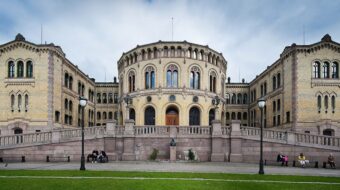Oscar Niemeyer, one of the world’s greatest architects, celebrated his 100 birthday on Dec. 14, 2007. Best known for the pioneering, breathtaking buildings he designed for Brazil’s capital, he has inspired generations of architects with his embrace of curves, creative use of concrete, and reliance on local materials and techniques.
And, as a communist who has experienced persecution, exile, and the shifting fortunes of our movement over the past century, his dedication to the struggle for a better world serves as an inspiration to a new generation of activists.
Niemeyer joined the Brazilian Communist Party in 1945 because, as he told the French newspaper L’Humanitė, ‘I understood right away that we had to change things. The path to change was the Communist Party. I joined the Party and have remained in the Party up to today, following all the ups and downs that life has imposed.’
Born on Dec. 15, 1907, in Rio de Janeiro, Niemeyer has spent his life melding his profession and his politics. His buildings are designed to convey hope for a just future while forcing rich and poor to interact in cultural, governmental, and residential settings. As he explained in the UK’s Guardian, ‘Many of my buildings have been political and civic monuments, but perhaps some of them have given ordinary people, powerless people, a sense of delight. That is what architects can do’
Niemeyer is a giant of the Modernism school of architecture, often hailed as a genius for his unique and influential contributions. Describing his work, Niemeyer recently told the Financial Times, ‘Mine is an architecture of curves, the body of a woman, the sinuous rivers, the waves of the sea.’
In 1956, Brazil’s populist president, Juscekino Kubitschek came up with the idea of building a new capital in the country’s central savannah. He invited his friend Niemeyer to design some of its most prominent structures, including the presidential residence, the congress building, the Palace of Justice, and the cathedral as well as a series of apartment blocks. The city, named Brasilía, was completed in only four years and Niemeyer’s creations dazzled the architectural world.
Today, Brazil’s capital has a population of 2.2 million and is designated a UNESCO World Heritage Site. Legislation recently proposed by Brazil’s president, Luiz Inácio Lula da Silva, who has declared 2008 ‘The Year of Oscar Niemeyer,’ would designate all of Niemeyer’s buildings in the country as special landmarks.
When the military staged a coup in 1964, Niemeyer’s offices were raided and his work was halted. He went into exile the following year, settling in Paris, where he continued to create architectural marvels such as the headquarters of the French Communist Party in Paris, the Penang State Mosque in Malaysia, and the campus of Constantine University in Algeria. He finally returned to Brazil in the 1980s after the collapse of the right-wing regime and since then has been based in his hometown of Rio.
In his office overlooking the beach, Niemeyer enjoys cigarillos and coffee, working on new commissions, hosting weekly political discussions, and welcoming visits by friends. He counts amongst his closest Fidel Castro, who once joked ‘Niemeyer and I are the last communists on this planet.’
At 100, he remains very active, designing cultural centers in Spain and Brazil and a new capital city for Angola as well as developing a magazine. And last year, he married his longtime assistant, Vera Lúcia Cabreira, eight years his junior.
Niemeyer often says it is life, not architecture that is really important. In an interview with the German magazine Spiegel, he declared ‘You have to keep your mind alive, work, help others, laugh, cry and experience life intensively. It only lasts for a brief moment.’
And in L’Humanitė, he offered these words of encouragement to fellow communists: ‘There are too many injustices. But commitment to the Communist Party provides hope, solidarity, and the realization that it is possible to struggle together for a better world.’











Comments